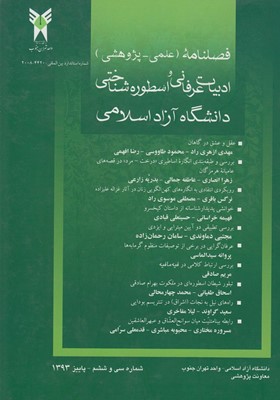تحلیلی روانشناسانه از داستان سیاوش بر مبنای الگوی ساختار ذهن فروید
محورهای موضوعی : اسطورهمحمدرضا روزبه 1 * , کیانوش دانیاری 2
1 - استادیار زبان و ادبیات فارسی دانشگاه لرستان
2 - دانشجوی دکتری زبان و ادبیات فارسی دانشگاه لرستان
کلید واژه: شاهنامه, فروید, روانکاوی, سختار ذهن, داستان سیاوش,
چکیده مقاله :
آرای فروید در حوزۀ روانکاوی تأثیری شگرف بر هنر و ادبیات نهاد و موجب ظهور نقد روانشناسانه شد. نظریههای ناخودآگاه فردی و ساختار ذهن و روان انسان از برجسته ترین دستاوردهای فکری این متفکر بود. بر اساس این نظریه ها، ساختار ذهن انسان دارای سه بخش عمده است: نهاد، من و فرامن. هرکدام از این بخش ها نیز مظهر بخشی از دنیای پیچیده ذهن و وجود آدمی هستند. شخصیت های اصلی داستان سیاوش قابلیت انطباق با این سه بخش را دارند و کنش های این سه می تواند از منظری تأویلی، معرّف کارکردهای اجزای ساختار ذهن باشد؛ سودابه مظهر نهاد، سیاوش معرّف فرامن و کاووس نمایندۀ من. از منظری دیگر می توان گرسیوز را معادل نهاد، سیاوش را مظهر فرامن و افراسیاب (و در بُعدی دیگر پیران) را نماینده من به شمار آورد. این پژوهش به تحلیل داستان سیاوش بر مبنای این رویکرد اختصاص دارد.
Freud's psychoanalytic theory has deeply influenced the literary works and works of art, and gave rise to psychological criticism. Personal unconscious and structure of mind theories are the most eminent results of Freudian outlook. According to these theories, the structure of mind has a tripartite structure: ego, id and super ego. Each one reflects a dimension of the human mind. In the story of Siyāvash, as narrated in Shahnameh, the prominent characters are the representative of the tripartite; Sudabeh as the symbol of id, Siyāvash as the super ego and Kavus as the ego. Action and reaction each one of them explains the structure of human mind. In the same way, and from another perspective, Afrasiab, king of Turan, can be seen as symbol of ego, Garsivaz, the brother of Afrasiab, as the symbol of id and Siyāvash as the symbol of super ego. Based on such an analysis, the present article reconsiders the story of Siyāvash.

